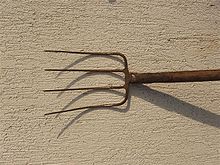Pitchfork
A pitchfork ( mhd . Die pitchfork , ahd . The mistcapala , mistgabala ) or dung fork is an agricultural tool with tines, about 170 cm long , which is mainly used to pick up and briefly transport manure and litter. A pitchfork is also called a fork , grape, mulch, fertilizer or dung fork depending on the landscape . The five-pronged fork is now often referred to by the trade name compost fork .
Building the pitchfork
The pitchfork consists of a fork-shaped head which is provided with four or five only very slightly curved prongs of approx. 30 to 40 cm in length. The handle is stronger and shorter than that of the pitchfork and also only slightly or not curved. The prongs are sharpened, however, due to the use for scratching and scraping. Historically, they were also made of wood, but are now made of steel .
In contrast, the pitchfork has a longer, thin and curved handle and two or three strongly curved prongs. Like all forks, the pitchfork is a constant source of accidents at work .
There is also a dung hoe with right-angled tines.
Using the pitchfork
The pitchfork is still used today on all farms as a universal tool for many tasks, even if its importance has decreased due to the mechanization of agriculture. It is used both for mucking out a stable, i.e. to remove animal excrement associated with litter in a wheelbarrow , and to spread the manure as fertilizer on so-called hotbeds or fields. When mucking out, the tines are often scraped vertically on the concrete or stone floor in order to loosen the excrement. Similar to the digging fork , the pitchfork is also suitable for being inserted deeply into solid material. The arrangement of the prongs allows you to step on it with your foot. It is also used for distributing and transporting litter.
The fire brigade also has such a device in the fire engines . It is used to loosen and pull apart burning material.
Manufacturing
Pitchforks used to be carved out of wood. The wear was very high. Today the fork head is made of high quality steel by forging. The shelf life is much higher. The fork is attached to the handle in northern Germany by means of a spring clamp or in central Germany by means of a forged socket and nail or screw. The spring clamp is a separate two-part component made of sheet metal consisting of a jacket and a cap. The clamp completely encloses the wooden handle at the end and is attached to the wood with two nails. The fork is then driven tightly into the wood of the handle from below by means of a mandrel and the spring clamp prevents wood from splitting. In the picture above you can see a pitchfork with a socket.
Unlike pitchforks, pitchforks have thicker, slightly curved handles, which are preferably made from flexible wood such as ash or other woods such as beech or oak.

